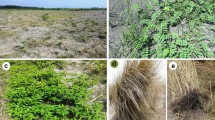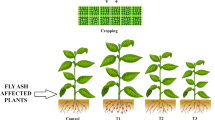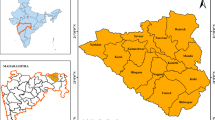Abstract
Field experiment on 10 ha area of fly ash dump was conducted to restore and revegetate it using biological interventions, which involves use of organic amendment, selection of suitable plant species along with specialized nitrogen fixing strains of biofertilizer. The results of the study indicated that amendment with farm yard manure at 50 t/ha improved the physical properties of fly ash such as maximum water holding capacity from 40.0 to 62.42% while porosity improved from 56.78 to 58.45%. The nitrogen content was increased by 4.5 times due to addition of nitrogen fixing strains of Bradyrhizobium and Azotobacter species, while phosphate content was increased by 10.0 times due to addition of VAM, which helps in phosphate immobilization. Due to biofertilizer inoculation different microbial groups such as Rhizobium, Azotobacter and VAM spores, which were practically absent in fly ash improved to 7.1 × 107, 9.2 × 107 CFU/g and 35 VAM spores/10 g of fly ash, respectively. Inoculation of biofertilizer and application of FYM helped in reducing the toxicity of heavy metals such as cadmium, copper, nickel and lead which were reduced by 25, 46, 48 and 47%, respectively, due to the increased organic matter content in the fly ash which complexes the heavy metals thereby decreasing the toxicity of metals. Amendment of fly ash with FYM and biofertilizer helped in profuse root development showing 15 times higher growth in Dendrocalamus strictus plant as compared to the control. Thus amendment and biofertilizer application provided better supportive material for anchorage and growth of the plant.
Similar content being viewed by others
References
Adriano, D. C. (1992). Bioengineering of trace metals. In Advances in trace substances research (p. 513). Boca Raton, Fl: Lewis.
Adriano, D. C., Page, A. L., Elseewi, A. A., Chang, A. C., & Straughan, I. R. (1980). Utilization and disposal of fly ash & other coal residues in terrestrial ecosystems: A review. Journal of Environmental Quality, 9, 333–343.
Aitken, R. L., & Bell, L. C. (1985). Plant uptake and Phytotoxicity of boron in Australian fly ashes. Plant Soil, 84, 245–257.
Bergey, D. H. (1984). Bergey’s manual of systematic bacteriology, vol. 1. pp. 200–204.
Beringer, J. E. (1974). R factor in Rhizobium leguminosarum. Journal of General Microbiology, 84, 188–202.
Black, C. A., Evans, D. D., White, J. L., Ensminger, L. E., & Clark, F. E. (1965). In: Methods of soil analysis: Chemical and microbiological properties, Agronomy 9, Part II, Madison, Wisconsin, USA.
Bolch, W. E., Jr. (1980). Solid waste and trace element Impact. In A. E. S. Green (Ed.), Coal burning issues, chapter 12 (p. 231). Gainesville: University Press of Florida.
Bouyoucos, G. T. (1939). Effects of organic matter on the water holding capacity and wilting point of mineral soils. Soil Science, 47, 377.
Chapman, H. D. (1982). Methods of analysis for soils, plant and water, priced publication, 4034. Berkeley: Division of Agricultural Science, University of California.
Cheung, K. C., Wong, J. P. K., Zhang, Z. Q., Wong, J. W. C., & Wong, M. H. (2000). Revegetation of lagoon ash using the legume species Acacia auriculiformis and Leucaena leuco-cephala. Environmental Pollution, 109, 75–82.
Clark, F. E. (1965). Agar-plate method for total microbial count. In C. A. Black et al. (Eds.), Methods of soil analysis. Part 2. Chemical and microbiological properties (pp. 1460–1466). Madison, WI: American Society of Agronomy.
Doran, J. W., & Martens, D. C. (1972). Molybdenum availability as influenced by application of fly ash to soil. Journal of Environmental Quality, 1, 186–189.
Fulekar, M. H., & Dave, J. M. (1990). Environmental impact assessment of fly ash from coal fired power plant. Encology, (4/8), 25–33.
Fulekar, M. H, Naik, D. S., & Dave, J. M. (1983). Heavy metals in Indian coals and corresponding fly-ash and their relationship with particulate size. International Journal of Environmental Studies, 9, 139–144.
Galli, U., Schuepp, H., & Brunold, C. (1994). Heavy metal binding by mycorrhizal fungi. Physiological Plantarum, 92, 364–368.
Gerdmann, J. W. (1963). Spores of mycorrhizal endogene sp. extracted from soil by wet sieving and decanting. Transactions of the British Mycological Society, 46, 235–239.
Gupta, D. K. (2002). Ecophysiological studies on Cicer arietinum L growing under fly ash stress condition. Ph.D. thesis submitted to Lucknow University, Lucknow.
Gupta, D. K., Rai, U. N., Tripathi, R. D., & Inouhe, M. (2002). Impacts of fly ash on soil and plant responses. Plant Research, 115, 401–409.
Hodgson, D. R., & Holliday, R. (1966). The agronomic properties of pulverized fuel ash, Chemical Industry, 20, 785–790.
Jackson, M. L. (1973). Soil chemical analysis. New Delhi: Print Ice Hall of India, Private Limited.
Juwarkar, A. S., Juwarkar, A., Pande, V. S., & Bal, A. S. (1992). Restoration of manganese mine spoil productivity through press mud utilization. In R. K. Singhal, A. K. Malhotra, & J. L. Collins (Eds.), Environmental issues and management of waste energy & production (pp. 827–830). Bookfield: Balkema.
Khaleel, R., Reddy, K. R., & Overcash, M. R. (1981). Changes in soil physical properties due to changes in organic waste applications, a review. Journal of Environmental Quality, 10(2), 133–138.
Klein, D. H., Andren, A. W., Carter, J. A., Emery, J. F., Feldman, C., Fulkerson, W., et al. (1975). Environmental Science & Technology, 9, 973–979.
Klute, A., & Jacob, W. C. (1949). Physical properties of sassafras silt loam as affected by long-time organic matter additions. Soil Science Society of America Proceedings, 14–24.
Kumar, V., & Mishra, B. (1991). Effect of two types of press mud cake on growth of rice–maize and soil properties. Journal of Indian Society for Soil Science, 39, 109–113.
Martens, D. C. (1971). Availability of plant nutrients in fly ash. Compost Science, 12, 15–19.
Martens, D. C., & Beahm, B. R. (1978). Chemical effects on plant growth of fly-ash incorporation into soil. In D. C. Adriano & I. L. Brisbin (Eds.), Environmental chemistry and cycling processes (pp. 637–644). CONF-760429-U. S. Dep. Comm. Springfield ver.
Metzger, L., & Yaron, B. B. (1987). Influence of sludge organic matter on soil physical properties. In B. A. Stewart (Ed.), Advances in Soil Science (pp. 141–145). New York: Springer-Verlag.
Misra, L. C., & Shukla, K. N. (1986). Effects of fly ash deposition on growth, metabolism and dry matter production of maize and soyabean. Environmental Pollution, 42, 1–13.
Mulhern, D. W., Robel, R. J., Furness, J. C., & Hensley, D. L. (1989). Vegetation of waste disposal area at a coal fired power (plants) on fly ash. Environmental Science & Technology, 13, 311–315.
NEERI report (2000). Demonstration project on restoration of manganese and coalmine spoil and fly ash dumps through an Integrated Biotechnological Approach, sponsored by department of biotechnology, New Delhi.
Parkinson, D. (1979). Microbes, mycorrhizae and mine spoil. In M. K. Wali (Ed.), Ecology and coal resources development (p. 634). New York: Pergamon.
Phung, H. T., Lund, L. J., & Page, A. L. (1978). Potential use of fly ash as a liming material. In D. C. Adriano & I. L. Brisbin (Eds.), Environmental chemistry and cycling processes (pp. 504–515). Springfield, VA: CONF-760429-U.S. Department of Commerce.
Piper, C. S. (1966). Soil and plant analysis. New York: Inter Science.
Rees, W. I., & Sidrak, G. H. (1956). Plant nutrition on fly ash. Plant Soil, 8, 141–153.
Sahu, K. C. (1998). Impact of residual soil on heavy metal leachate from ash pond at Korba-en experimental approach. Indian Journal of Environmental Protection, 18, 498–504.
Stokowski, S. J. (1988) Jr. Proceedings of the Annual Meeting of the Society of Mining. Arizona: Phoenix.
Thakur, D. N., Dhar, B. B., Sanyal, S., Murty, N. B., K., & Grover, S. K. (1995). On environmental issues at coal-fired thermal power plants in India and disposal of fly ash (pp. 943–977). First world Mining Environment Congress, New Delhi, India.
Theis, T. L., & Wirth, J. L. (1977). Sorptive behavior of trace metals on fly ash in aqueous systems. Environmental Science & Technology, 11, 1096–1099.
Tripathi, R. D., Singh, S. N., Singh, N., Vajpayee, P., & Kumar, A. (2000). Reclamation of fly ash landfills by successive plantation, soil amendments and/or through biotechnological approach. Final Technical report submitted to Directorate of Environment, U.P.
Unger, P. W., & Stewart, B. A. (1974). Feedlot waste effects on soil conditions and water evaporation. Soil Science Society of America Proceedings, 38, 954.
Walkley, Y. A., & Black, I. A. (1934). ‘An examination of the Degtjareff method for determining soil organic matter and a proposed modification of the chromic acid titration method’. Soil Science, 37, 29.
Wong, M. H., & Wong, J. W. C. (1990). Effects of fly ash on yields and elemental composition of two vegetables, Brassica parachinensis and B. chinensis. Agriculture, Ecosystems & Environment, 30, 251.
Author information
Authors and Affiliations
Corresponding author
Rights and permissions
About this article
Cite this article
Juwarkar, A.A., Jambhulkar, H.P. Restoration of fly ash dump through biological interventions. Environ Monit Assess 139, 355–365 (2008). https://doi.org/10.1007/s10661-007-9842-8
Received:
Accepted:
Published:
Issue Date:
DOI: https://doi.org/10.1007/s10661-007-9842-8




